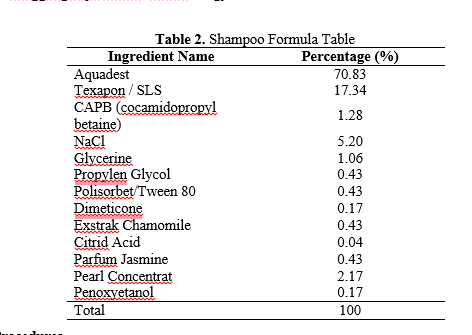Shampoo With Basic Ingredients Chamomile Flower Extract (Matricaria Chamomilla): Formulation and Evaluation of Preparations
DOI:
https://doi.org/10.26555/ijce.v1i2.676Keywords:
haircare, shampoo, hair health, Chamomile, 1-3-4-trihydroxyflavonesAbstract
Proper hair maintenance is a crucial component of one's daily beauty regimen. Shampoo, a commonly utilized hair care solution, has a chemical blend that effectively eliminates filth while also offering moisturization and safeguarding. The objective of this study is to create shampoo formulations and preparations with chamomile extract. The chamomile flower extract contains active chemicals, specifically 1,3,4-trihydroxyflavones called apigenin and apigenin 7-o-glucoside. These compounds have several beneficial effects such as enhancing hair brightness and shine, as well as possessing antibacterial, antifungal, hypoglycemic, and antioxidant qualities. Shampoo's chemical composition is determined by analyzing factors such as pH, foamability, homogeneity, total plate count, yeast mold count, and other similar parameters. Upon examination of these criteria, it is evident that the formulation and shampoo formulations successfully complied with the test requirements outlined in SNI 06-2692-1992.
References
M. S. Roberts, V. R. Leite-Silva, and K. A. Walters, Cosmetic Formulation. 2019.
Y. Nia et al., “Formulasi Dan Evaluasi Sediaan Shampoo Dengan Bahan Dasar Ekstrak Bunga Chamomile (Matricaria Chamomilla) : Literature Review Article,” vol. 9, no. 16, pp. 1–7, 2023.
U. Nafisah, Y. Diyan Permata Sari, and L. Nur Latifah, “Formulasi dan Evaluasi Fisik Sediaan Gel Sampo Minyak Atsiri Bunga Chamomile (Matricaria recucita L.) dengan Variasi Konsentrasi HPMC,” Parapemikir J. Ilm. Farm., vol. 12, no. 1, p. 136, 2023, doi: 10.30591/pjif.v12i1.4435.
E. Fernández, B. Martínez-Teipel, R. Armengol, C. Barba, and L. Coderch, “Efficacy of antioxidants in human hair,” J. Photochem. Photobiol. B Biol., vol. 117, pp. 146–156, 2012, doi: 10.1016/j.jphotobiol.2012.09.009.
E. Laelasari and I. Musfiroh, “Indonesian Journal of Biological Pharmacy Review Article : Potential of Herbal Plants Against Pityrosporum ovale Fungus Causes of Dandruff,” vol. 2, no. 3, p. 153, 2022.
T. C. Malonda, P. V. Y. Yamlean, and G. Citraningtyas, “Formulasi Sediaan Sampo Antiketombe Ekstrak Daun Pacar Air ( Impatiens balsamina L .) dan Uji Aktivitasnya Terhadap Jamur Candida Albicans Atcc 10231 secara In Vitro,” vol. 6, no. 4, 2017.
H. Azzahra et al., “Indonesia Bachelor Program of Chemistry Education, Faculty of Teacher Training and Education,” Univ. Sebel. Maret., vol. 8, no. 1, pp. 114–127, 2023, [Online]. Available: https://jurnal.uns.ac.id/jkpk
R. S. Pal, N. Saraswat, P. Wal, A. Wal, and Y. Pal, “Preparation & Assessment of Poly-Herbal Anti-Dandruff Formulation,” Open Dermatol. J., vol. 14, no. 1, pp. 22–27, 2020, doi: 10.2174/1874372202014010022.
A. R. Saraswati, N. A. Putriana, F. Farmasi, and U. Padjadjaran, “13323-29034-1-Pb,” vol. 15, pp. 248–261.
R. D. Sinclair, “Healthy Hair: What Is it?,” J. Investig. Dermatology Symp. Proc., vol. 12, no. 2, pp. 2–5, 2007, doi: https://doi.org/10.1038/sj.jidsymp.5650046.
R. BPOM, “Peraturan BPOM RI No. 17 Tahun 2022 Tentang Persyaratan Teknis Bahan Kosmetika,” Bpom Ri, no. 702, pp. 1–337, 2022.
E. Nurhikma, D. Antasari, and Austin Selfyana tee, “Formulasi Sampo Antiketombe dari Ekstrak Kubis Kombinasi Ekstrak Daun Pandan Wangi,” J. Mandala Pharmacon Indones. , vol. 4, no. 1, pp. 61–67, 2018.
G. Jennifer, R. Vito, F. Paola, and C. Pinalysa, “Hair Care Cosmetics: From Traditional Shampoo to Solid Clay and Herbal Shampoo, A Review,” Cosmetics, vol. 6, no. 1, pp. 1–16, 2019, doi: 10.3390/cosmetics6010013.
K. Al Badi and S. A. Khan, “Formulation, evaluation and comparison of the herbal shampoo with the commercial shampoos,” Beni-Suef Univ. J. Basic Appl. Sci., vol. 3, no. 4, pp. 301–305, 2014, doi: 10.1016/j.bjbas.2014.11.005.
A. E. Al-Snafi, “Medical Importance of Anthemis Nobilis (Chamaemelum Nobile): A Review” Asian Journal of Pharmaceutical Science & Technology, vol. 2, no. 2, pp. 89–95, 2016, [Online]. Available: www.ajpst.com
S. Sulistiana and S. Tarini Darijanto, “Formulasi Dan Evaluasi Mikroemulsi Gel Minyak Chamomile Serta Uji Aktivitas Antioksidan,” Indones. J. Pharm. Educ., vol. 2, no. 1, pp. 52–66, 2021, doi: 10.37311/ijpe.v2i1.11231.
U. S. Abelan et al., “Potential use of essential oils in cosmetic and dermatological hair products: A review,” J. Cosmet. Dermatol., vol. 21, no. 4, pp. 1407–1418, 2022, doi: 10.1111/jocd.14286.
Z. D. Draelos, “Shampoos, Conditioners, and Camouflage Techniques,” Dermatol. Clin., vol. 31, no. 1, pp. 173–178, 2013, doi: 10.1016/j.det.2012.08.004.
S. Kusmiati and R. Yulianti, “Formulasi Sampo Ekstrak Buah Mengkudu (Morinda citrifolia L.) dan Uji Aktivitas terhadap Pityrosporum ovale,” Prosing Semin. Nas. Disem. Has. Penelit., vol. 2, pp. 144–151, 2022.
T. Mitsui, “New Cosmetc Science. First Edition,” Elsevier Sci. B.V., pp. 13–21, 1997.
A. S. Sari and R. H. Hayati, “Formulasi Sediaan Shampo Antiketombe Ekstrak Jahe (Zingiber officinale Rosc)” Indones. J. Pharm. Nat. Prod., vol. 2, no. 1, pp. 4–7, 2019, doi: 10.35473/ijpnp.v2i1.195.
H. G. Salsabila, N. M. Zamruddin, and H. Herman, “Optimasi Konsentrasi Basis HPMC Sediaan Sampo Antiketombe Ekstrak Daun Belimbing Wuluh (Averrhoa bilimbi L.) Kombinasi Ekstrak Daun Pandan Wangi (Pandanus amaryllifolius Roxb),” Proceeding Mulawarman Pharm. Conf., vol. 15, pp. 94–99, 2022, doi: 10.25026/mpc.v15i1.624.

Downloads
Published
Issue
Section
License
Copyright (c) 2023 Adi Permadi, Stradivary Maulida Firdaus , Abdul Aziz , Ahmad Fatwa Zufar

This work is licensed under a Creative Commons Attribution-ShareAlike 4.0 International License.

